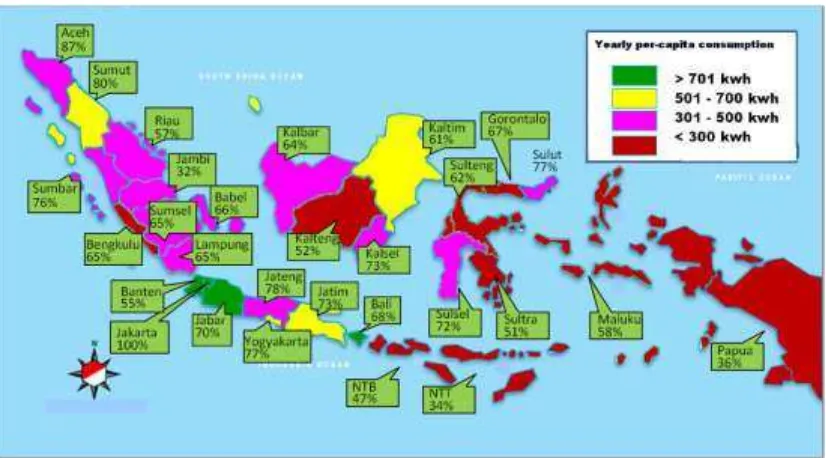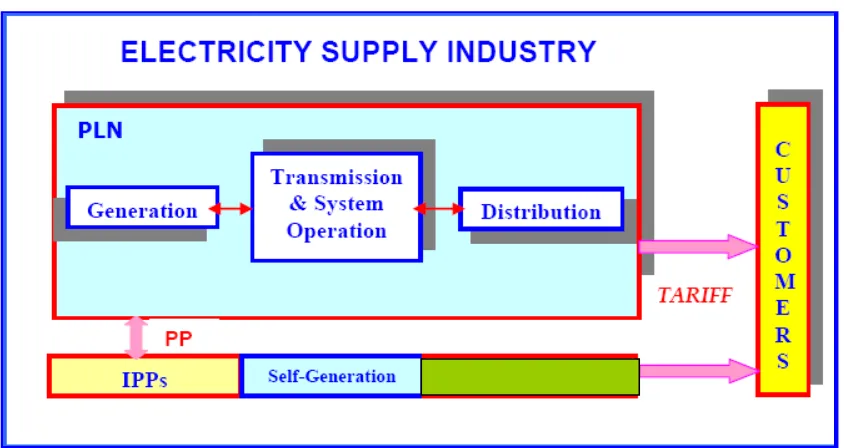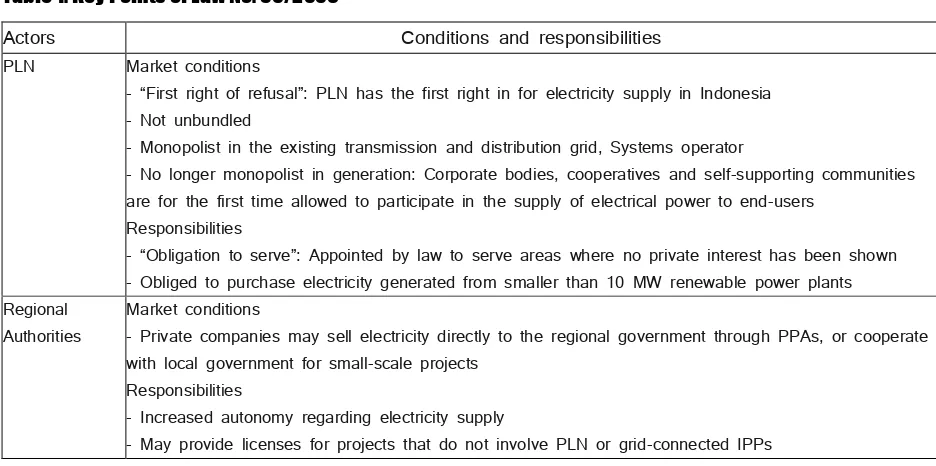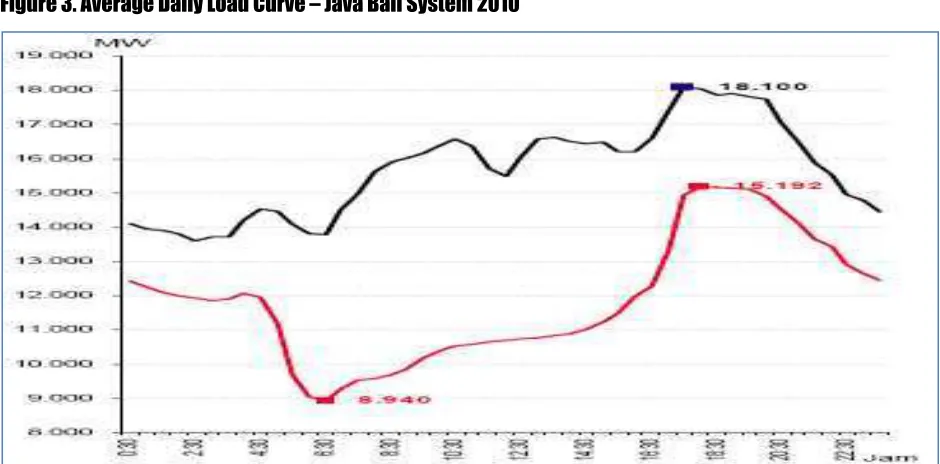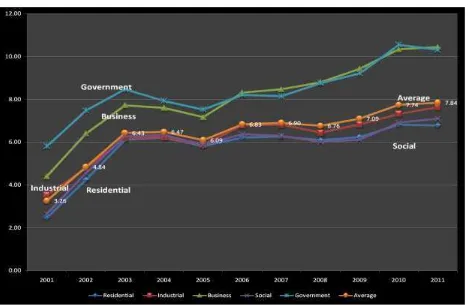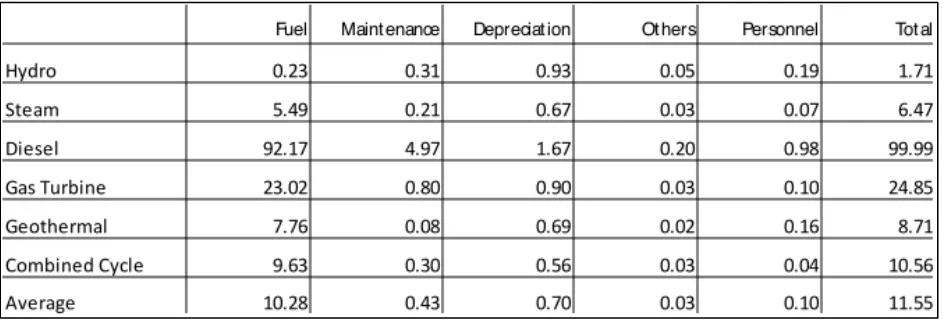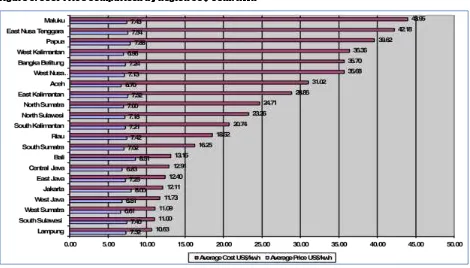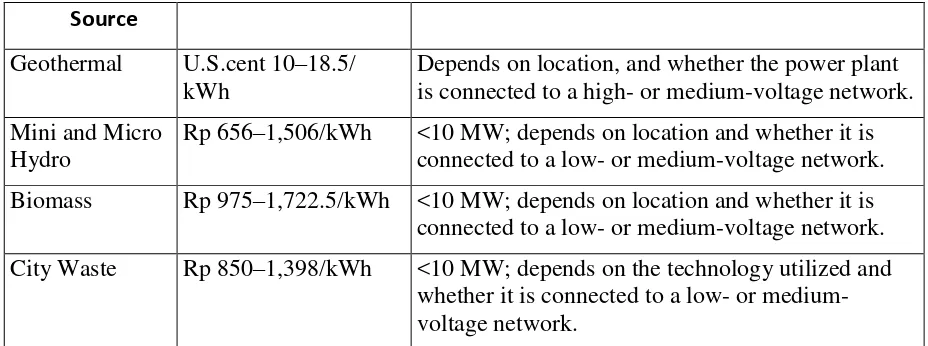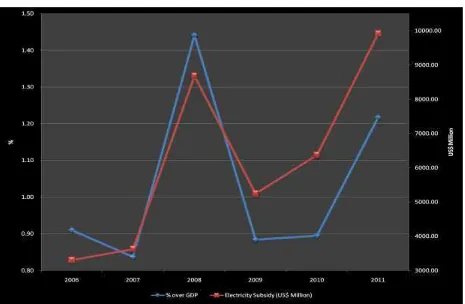1
Pricing Practices
in Indonesia’s Electricity Power Services
Yose Rizal Damuri Head of the Department of Economics, Centre for Strategic and
International Studies (CSIS) - This Policy Research Paper was prepared for the Indonesia
Services Dialogue under the USAID-SEADI project.
Introduction
Indonesian electric power sector has been struggling to meet the increasing demand of electric power. With an average economic annual growth of 6% and growing population, Indonesia has been experiencing power crisis for around a decade. During the first decade of
the new millennium, the demand was estimated to grow around 6.5% per year1 , while the
industry only managed to increase its capacity by less than 6% annually. As a result, electric power coverage and utilization is still very low compare to other countries as Figure 1 described.
Figure 1
. Indonesia’s Electrification Ratio
and per-capita Consumption 2011
Source: StatistikPLN 2011, compiled by the author
1
Muchlis, M. and Adhi Darma Permana
(2006), “Proyeksi
Kebutuhan Listrik PLN di Indonesia
The national coverage of electricity power services is 70%; the western part of the archipelago
electrification ratio of higher than 70%, but the eastern part has electrification ratio below 40%. The
average consumption is around 655 kWh for the country, but some provinces consume less than 300
kWh, particularly in the eastern part of the archipelago. While the condition has improved, the demand will remain high with a new projection of 10.1% growth per annum for the period of
2008-20272. This situation is likely to put Indonesia’s economic development in jeopardy.
There are three areas of problem that need to be addressed by adopting more market-friendly regulations in Indonesia’s electricity sector. The first is the current industrial structure and arrangement that is supportive to the development of infrastructure and delivery of quality electricity service. The second is the absence of effective regulatory arrangement and legal framework. The third problem relates to the financing of operation. The current tariff structure neglects cost-recovery and economic principles. This policy has lead to severe fiscal problems and lack of incentive to adopt new and efficient technologies, along with low participation from the private sector.
This paper focuses on the third problem; namely the tariff structure that is not economically sustainable. Before examining the cost and tariff structure, an overview of Indonesia’s electricity industry is briefly explored to provide background on the industry’s situation. It is followed by a discussion on the current regulatory framework of the industry. The cost structure of Indonesia’s electricity services is examined together with price-setting practice and government subsidy. The paper is concluded with a discussion on pricing policy options.
Current Industry Structure
The activities within the electricity industry are categorized into three: generation of power, transmission of power and distribution and sale. These activities are different yet related. The former Law Number 15 Year 1985 on Electricity regulated that the electricity supply in Indonesia was conducted by the state through Perusahaan Listrik Negara (PLN), the state-owned electricity utility. Private sector was given the opportunity operate power plan for the intention of selling it to PLN. The new 2009 Law preserves such arrangement, although
2
Kementerian Energi dan Sumber Daya Manusia, Rencana Umum Ketenagalistrikan Nasional
3 provide bigger opportunity to private sector. Figure 2 shows the structure of Indonesia’s electric power services.
The electrical power generation sub-sector has been partially liberalized since early 1990s when the government invited private investors to participate in the power sector by operating large-scale independent power producers (IPPs). However, those IPPs are only allowed to sell their services to PLN based on specific power purchase agreement (PPA) specifying the amount and agreed selling prices of the services for certain period. The contract is normally awarded through competitive bidding, or whenever possible through direct appointment. In addition, there are also smaller power plants operating for limited areas or for self-purpose known as private power utilities (PPU). Around 78% of national installed capacity belongs to PLN, while 16% of the capacity is controlled by the IPPs.
Figure 2. Structure of Indonesia’s Electric Power Services
than 4000 MW capacity to start operation within one or two years.3 However, past experiences show that many private projects face various major problems especially in investment financing and purchasing agreement, which may postpone and even cancel the future operation.
Transmission, distribution and selling activities are controlled solely by PLN except for small networks servicing limited areas. The 1985 law did not permit private sector participation in distributing and selling the energy. Under this law, PLN was the sole owner of national transmission and distribution assets, and the only entity in charge of using the facilities. Except for several small closed private electric networks normally operates in industrial areas, PLN is virtually the sole supplier of electricity by producing or buying power, transmitting, distributing and selling the services to consumers.
Private sectors that had intention to sell their produced power were required to develop and build their own closed off-grid networks. Those companies hold a special license that allows each company to generate electricity and only sell the services to limited number of consumers. Most of them are industrial estate and building managements, hospitals, schools and others. Some cooperatives and local government agencies also operate in the areas uncovered by PLN’s services.
Recent Development in Regulatory Framework
In September 2002, the Government of Indonesia enacted Law No. 20 on Electricity replacing the old law No. 15/1985. The new law is intended to introduce reform to the electricity industry from previously monopolistic structure into a limited competitive market within a five-year time frame. Three main activities (generation, transformation and distribution), that were previously integrated under the control of PLN, were unbundled, allowing for private investors’ participation in each activity. The government expected better financing for the development of power services. Unfortunately in December 2004, Indonesia’s constitutional court annulled the two year-old electricity law on the ground that it violates the
constitution by giving up control of the electricity service market to the private sector4.
4Purra, M.,“Institutional and Regulatory Reform in the Indonesian Electricity Secto
5 An important recent change on the regulatory framework was the passing of Law No. 30/2009, which is intended to complement other recent policies and actions in improving the industry condition, and help the government in achieving its social and environmental goals. The new law can be seen to be an improvement from the previous 1985 law, although carries less reform and liberalization spirits than the annulled the 2001 law. In essence, electric power services are still controlled by the government; however, the supply may be conducted by either the central or regional governments through PLN, or regionally owned utilities. The largest change in the new electricity law is that it promotes more actively participation by private sectors (IPPs) including in retail selling of the power.
Table 1 summarizes several important aspects of the new law with regard to the industry reform attempts. The law stipulates that private investors are now able to sell directly to the end user as long as it operates in the area not being served by PLN. It also give more power to the regional authorities in awarding licenses for private electricity projects or to set-up large scale local government companies to provide electricity services.
Table 1. Key Points of Law No. 30/2009
Actors Conditions and responsibilities
PLN Market conditions
- F l : L has the first right in for electricity supply in Indonesia - Not unbundled
- Monopolist in the existing transmission and distribution grid, Systems operator
- No longer monopolist in generation: Corporate bodies, cooperatives and self-supporting communities
are for the first time allowed to participate in the supply of electrical power to end-users Responsibilities
- l : A y l
- Obliged to purchase electricity generated from smaller than 10 MW renewable power plants
Regional Authorities
Market conditions
- Private companies may sell electricity directly to the regional government through PPAs, or cooperate with local government for small-scale projects
Responsibilities
- Increased autonomy regarding electricity supply
IPP Market conditions
- Areas not already served by PLN may be served by private businesses as long as the specific area is l L ’ l l
- IPPs generating electricity in areas already served by PLN may only sell electricity to PLN (PPA) - Captive generation: May be conducted by government agencies, regional government, state-owned companies, regional-owned companies, private corporate bodies, cooperatives and individuals. Needs to
hold a government issued permit Responsibilities
- Private business need a license to provide electricity for public use - an IUPTL - granted by the central government to sell electricity directly to end-users
- Need to build transmission and distribution grid if supplying directly to end-users
The Government Regulation No. 42/2012 further specifies the possibility for providers in possession of transmission and distribution assets to rent out the facilities to other providers. Private investors that are willing to serve their consumers might not need to build their own transmission or distributions networks but rather to rent the network from existing providers such as PLN. All these new regulations may change the structure of the market in the future: whether it would end the PLN 60 year of monopoly and improve the industry’s performance remains to be seen.
PLN Selling Price
Electric power price of PLN has been traditionally set by the government via Presidential Regulation after receiving recommendation from various relevant authorities. Several regulations provide guidelines to various factors determining the regulated prices. However there is no specific guideline about how often the adjustment can take place. The current schedule of electricity tariffs was set in January 2013 to replace the old 2010 schedule. Currently there is no clear guideline to decide when a change of tariff schedule is necessary.
7 taken place. As a result of huge exchange rate depreciation, the average price in US$ fell down significantly from around US$ 7 cent to only US$ 2 cent.
Instead of applying automatic adjustment mechanism, the government sets the price that PLN can charge to the consumers and provide subsidy to cover the cost-revenue gap. Without having the ability to increase the selling price, PLN’s revenue is no longer able to cover generation and distribution costs, which increases substantially during the crisis. The situation is exacerbated by the fact that PLN was, and still is, the only buyer of private power plants production. Virtually all purchasing agreements were defined in long terms contracts where the purchasing price was set in US$, creating huge burden to the cost of production of PLN.
While the economy was recovery throughout the year 2000, the government made some attempts to increase the price back to the pre-crisis level. Several price increases have been
made but relatively negligible to cover the increasing costs. The PLN’s selling price hike have
always been responded by resistance from wider public, thus discourage the government to increase price even further. Moreover, the government also needs to consult the parliament before can get through with the plan of having price increase. From 2003 to 2010 there was no price adjustment for PLN’s electricity power due to political pressure and public resistance. In 2012, the government also had a plan to increase the price, but could not get approval from the parliament. Only after the 2010 price increase that the average price has reached the pre-crisis level, thanks also to exchange rate appreciation.
There are four main characteristics of current PLN selling prices. First, the classification
of tariff rate based solely on consumer characteristics. There are six main price categories in tariff schedule of the company: (i) residential, (ii) business, (iii) industrial, (iv) social activities, (v) government and (vi) street-light purpose. The groups are further classified based on
maximum power installed for the customers. Second, each group pays different basic charge
and utilization charge. The basic charge is higher for costumers with higher power installed in their premises, while power utilization is priced progressively according to monthly usage.
Fourth, there is no other characteristic used in determining electricity service pricing. The tariff schedule does not take account differences in daily and weekly load demand between the peak and off-peak time although as illustrated in Figure 3, the difference between those is very significant. This has put additional burden on PLN’s power facilities, uniform price during peak and off-peak time does not provide incentives to the consumers in order to use electric power more efficiently. Neither has it taken into account geographical differences nor the availability of power supply in different regions. The schedule applies throughout Indonesia, except for the region of Batam.
Figure 3. Average Daily Load Curve – Java Bali System 2010
Source: Statistik PLN Penyaluran dan Pusat Pengatur Beban Jawa Bali 2010
9 additional value added taxes (VAT) 10%. The VAT is waived for most of the customers, although there has been some discussion to apply the tax to more categories of customers.
Figure 4. Average Selling Prices of PLN
Source: Perusahaan Listrik Negara, Electricity Statistics, various years
PLN introduced in 2005 a flat-rate pre-paid option that has been quite popular in the last two years especially among residential and business consumers. By 2011, PLN claimed that more than 5 million consumers have chosen the new payment option, and expect to see 50%
increase this year.5 Pre-paid option allows consumers to manage the usage more efficiently
while reduce unclaimed invoices burden to the company.
5
Cost Structure
PLN’s operation is marked by high cost of generation and transmission. Ever since the Asian financial crisis in 1997-1998, the company has hardly generated sufficient revenue to cover its operation, which has made it rely heavily on energy subsidy from the government. Uniform tariff schedule across country also exacerbates this situation since generation and distribution costs vary significantly between regions. One of the reasons for high generation costs is the choice of utilization of power generation.
Generation cost of power companies depends on the cost of obtaining primary source of energy which varies according to the type of power plant. Some primary fuels are quite costly, e.g. oil-based fuels and coal, while other primary sources can be obtained almost freely, e.g. hydro and geothermal, but require substantial initial investment. During the last 10 years, the price of oil increase by almost 1000%, bringing the cost of generation of diesel plants to rise by
over 800%.6 The price of other primary energies also increases during the period, but much less
than oil. With 37% of the power come from oil-based generators, recent oil and fuel hike has given tremendous burden to the company operation.
Table 2 presents general cost structure of various types of power plants. Oil-based plants, such as diesel generators and diesel steam plants require high cost of production in all items, particularly on primary materials. Coal-based power plants, another type of plants commonly found in Indonesia, also face similar material price increase, although not as severe as oil plants.
PLN operates several hydro and geothermal power plants where the primary energy can be collected at low cost. There are also several private companies (IPPs) operating geothermal power plants in addition to PLN’s self-operated plants. The state-owned company is currently promoting the use of geothermal by attracting more investors to participate in supplying the energy and increasing its portion from the current level of 2.7%. While the cost of generation for these types of plants is low, high upfront capital requirement has obstructed the development of such energy sources. For example, the investment cost of PLTP Wayang Windu II is up to US$ 300 million to develop a power plant with the capacity of 110 MW.
6
11 Table 2. PLN Cost Structure by Type of Power Plants (US$ Cents)
Source: Perusahaan Listrik Negara, Electricity Statistics, 2011
The cost of obtaining energy in a geothermal power plant is relatively low. Currently, the government does not have specific charge for the energy acquired by geothermal power plants. According to the regulation, those companies, however, need to pay 34% of its net revenue as an all-inclusive tax, i.e. including income taxes, but in order to promote the development of the energy, the government currently agreed to undertake the withholding income tax of the companies operating geothermal plants, based on a certain quota set every year. In 2012 the government sets aside Rp 815 billion (around US$ 85 million) to pay the withholding income tax of those companies.
Except for hydro power and geothermal, Indonesia has not been up to renewable source of energy, e.g. solar and wind. Hydro power plants, which requires lesser inputs and low generation costs, only accounts for 9% of energy production although the installed capacity of this type of plant is much higher than 13.5%. Relatively low utilization of hydro plants is due to various difficulties ranging from natural conditions to distribution problem.
Different cost of operation can also be observed across different regions (Figure 5). The difference between low cost region and higher ones is very substantial reaching up to three times. As mentioned earlier, selling price is set identical for all regions resulting to similar average prices around US 6 cents.
cent. Part of the difference in costs comes from the utilization of relatively small oil-based power plants in many areas. In Maluku, Nusa Tenggara and Papua, 100% of power is supplied by numerous small diesel generators serving many isolated areas. The situation is made worse by geographical features of those regions, which require intensive transmission and distribution system. Those regions with high geographical difficulties tend to experience very high costs along with low coverage of services. Meanwhile, regions with low-cost power plants such as hydropower tend to have low costs of services. South Sulawesi, which obtains 80% of its power from hydro and gas plants, is among the least costly region. Regions with highly developed networks and denser population, such as western part of the archipelago, also have relatively low costs, partly due to low distribution cost.
Figure 5. Cost-Price Comparison by Region US$ Cent/KWh
Source: Perusahaan Listrik Negara, Electricity Statistics, 2010
PLN’s Purchasing Price of IPP’s Power
13 due to currency mismatch problem. Private sector operation was back on track in 2005 after renegotiation took place and PLN was ready to solve the debt problem.
PLN purchasing price of IPP’s power is specified in a contract between the state-owned company and private investors. The purchasing arrangement begins with the competitive bidding process, although in limited cases direct appointment may be permitted. The bidding process is initiated in accordance to the PLN plan and roadmap for additional power. The tender evaluates certain criteria including technical parameters, the proposed price and construction schedule. The proposed price from IPP is normally the most important determinant to select preferred bidder although both parties normally have a chance to negotiate the final price.
While the purchasing price of PLN for the electric power of IPP varies according to the type of primary sources of fuel, location, and initial capital outlays, in average the price is above the state-owned company’s final selling price to the costumers. The two biggest power suppliers to the PLN, Paiton Energi (23.1%) and Jawa Power (20%) receive average price of around US$8.3 cent/kwh in 2011, while PLN average selling price is no more than US7.8 cent/kwh. However, the purchasing prices remain to be unattractive to private investors considering that the investment require big initial outlay.
In order to attract private participation, the government has set several incentives including setting purchasing prices that are considered high enough to cover IPP’s operation. In 2011, the government decided to change the pricing policy from maximum price that PLN can offer to private power plants to feed-in-tariff scheme, especially for electric power from renewable energy.
A feed-in tariff (FIT) sets a guaranteed purchasing price for renewable electricity generated by IPPs. The FIT is set by the government at the start of the project with an assurance that PLN will take all the electricity produced by the power plant in question. This price certainty reduces the risk associated with recovering investment and operational costs. A
guarantee of this kind is particularly important in Indonesia, where the PLN’s domination of
transmission and distribution makes the electricity market a monopsony. Table 3 provides information on FIT for electric power from various renewable energy.
Table 3. Feed-in Tariff for Renewable Energy
Source
Rp 656
–
1,506/kWh
<10 MW; depends on location and whether it is
connected to a low- or medium-voltage network.
Biomass
Rp 975
–
1,722.5/kWh <10 MW; depends on location and whether it is
connected to a low- or medium-voltage network.
City Waste
Rp 850
–
1,398/kWh
<10 MW; depends on the technology utilized and
whether it is connected to a low- or
medium-voltage network.
Source: MEMR Regulation 12/2012 and MEMR Regulation 4/2012, compiled
Subsidy
The big discrepancies between selling price of power and PLN costs of operation has resulted to heavy subsidy to the company. Electricity subsidy to PLN in 2011 reached US$ 10.24 billion, which is around 10% of the year government expenditure. This is much higher than the proposed subsidy set aside in 2011 budget of US$7.2 billion. It accounts for 27% of the total subsidy, and together with fuel subsidy has taken a big part of Indonesia’s budget every year.
Figure 6 present historical trend of electricity subsidy. Although in terms of portion to GDP, the subsidy remains relatively the same, it increases significantly every year. Despite some efforts from the government and PLN to raise supplying capacity of low-cost power plants, the amount of subsidy is expected to increase in the future due to the growing consumption of the energy.
Uniform pricing scheme that fails to capture differences between geographical regions is one of the main sources of huge cost-revenue gap. The inability of PLN to charge higher price during peak consumption time also contributes to the situation. Instead of increasing revenue, the company needs to suffer high peak load during busy time of working days that escalate operation costs.
15 The proposed electricity price increase would be just approved two years after, resulting to heavy burden to the fiscal.
Figure 6. Indonesia’s Electricity Subsidy
Source: State Budget, various years
Conclusion and Policy Recommendation
Part of Indonesian electricity problems come from pricing practice that neglects cost-recovery principle and sustainability of operation. Electricity tariff structure fails to generate sufficient revenue to cover PLN’s operational costs, not to mention for expansion and new investments. High cost in generating power is due to the selection of primary sources of power that depends heavily on diesel fuel. The move toward cheaper natural gases and coals as sources of power is not rapid enough to cater for growing demand, partly due to lack of investment financing. This has forced PLN to obtain power from costly diesel generators. As a result subsidy for electricity has been increasing over the time.
In addition to the shift towards cheaper sources of power, PLN and the government need to change their tariff structure to represent the cost of operation. There are three considerations that the government needs to pay attention in restructuring electricity tariff.
First, the government needs to reintroduce automatic tariff adjustment that ensures financial stability of PLN. One way to have it is to decompose tariffs into two components: base tariff and adjustment component. Base electricity tariffs can be determined by the government for a specific period of time and should be adjusted accordingly. The second component should take into account economic shocks, e.g. exchange rate fluctuation, fuel price shock, and unanticipated demand. The adjustment component can be evaluated several times a year, say each quarter, to reflect cost situation appropriately.
Second, tariff structure should incorporate the difference between peak and off-peak time to discourage inefficient use of electricity power especially during high demand period. While it may not be politically feasible to apply different tariffs for different regions, it may be done through additional charges based on geographical characteristics. Another thing that can be incorporated into tariff structure is additional charges for the use of renewable energy, which is normally more costly than traditional primary sources. It can be conducted based on voluntary basis for certain costumer groups.
17 customers mostly for non-productive use. It is then necessary to limit subsidy only to specific few groups. It can be identified following the installed power of each household; this is the existing policy under current tariff schedule. It can then be expanded to more specific targeting, by including several characteristics of the households, e.g. income or assets.
